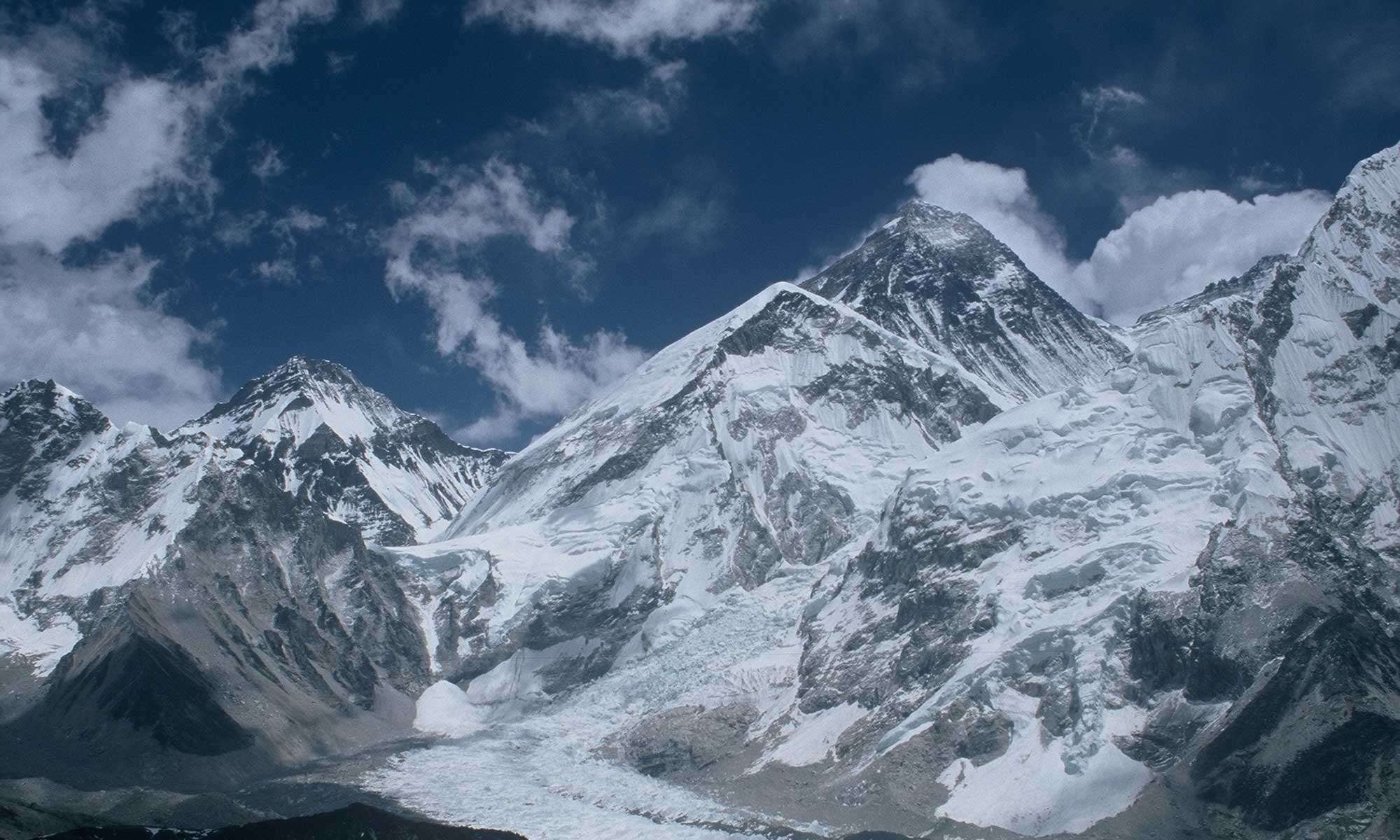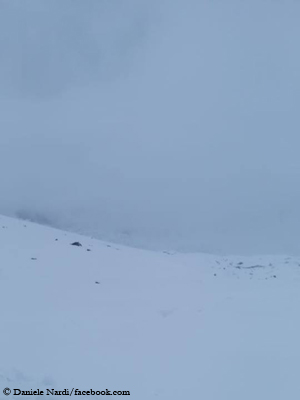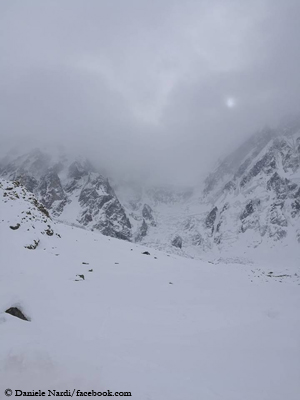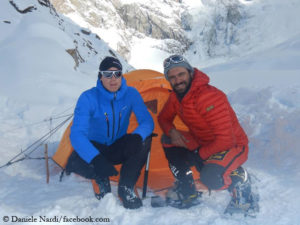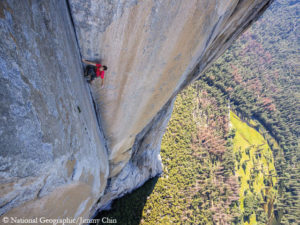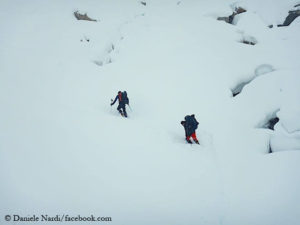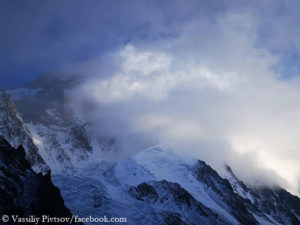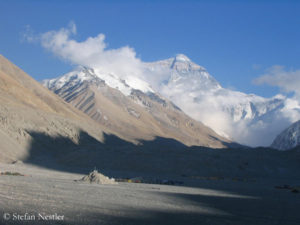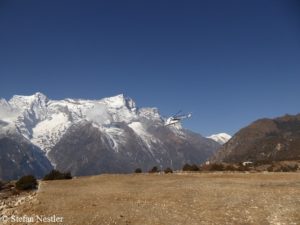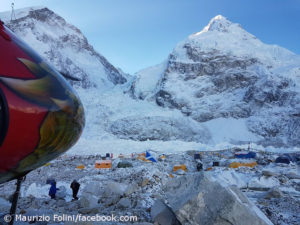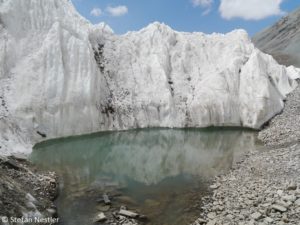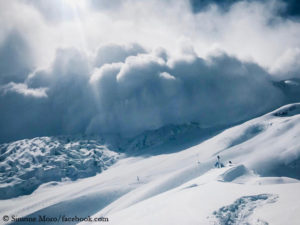Finally the weather has cleared up again at Nanga Parbat, so that the search for the climbers Daniele Nardi and Tom Ballard, who have been missing for eight days, has been resumed. With a military helicopter the Spaniard Alex Txikon, three of his team members and the Pakistani mountaineer Rahmat Ullah Baig were flown today to the ninth highest mountain in the world. “We have pitched up our Camp on the plateau between Camps 1 and 2 at an altitude of 4,850 meters,” Alex reported according to montagna.tv. “The weather is splendid”. But due to the warm temperatures the danger of avalanches is increasing, says the 37-year-old, adding that they reconnoitered the mountain by helicoptery very accurately – the Kinshofer route, then the Mummery Rib and finally the glacier area between Camp 3 and the spot where the helicopter landed. “We reached an altitude of about 7,100 meters. Unfortunately there are no visible traces of our friends.” Txikon wanted to climb up to Camp 2 with another mountaineer. The team will also search the area with camera drones.
Continue reading “Nanga Parbat: Search for Nardi and Ballard resumed”Still no sign of life from Nardi and Ballard
We defend ourselves internally against it. However, slowly, but surely the hope of being able to find the climbers Daniele Nardi and Tom Ballard, who are missing on Nanga Parbat, alive is fading. For six days there has been no sign of life from the 42-year-old Italian and the 30-year-old British. Thick clouds hid the 8,125-meter-high mountain on this Saturday and prevented again that the rescue action could be continued. As the weather was also bad on K2, the plan to take the Spaniard Alex Txikon and three of his team members by helicopter to Nanga Parbat could not be implemented. Txikon and Co. want to support Muhammad Ali “Sadpara” and two other Pakistani mountaineers in their search for Nardi and Ballard, among others things by using two drones.
Continue reading “Still no sign of life from Nardi and Ballard”Bad weather and bureaucracy hinder search for missing climbers
A lost day. Low clouds around Nanga Parbat today prevented the helicopters from taking off again to search for the two climbers missing since Sunday, 42-year-old Italian Daniele Nardi and 30-year-old Brit Tom Ballard. In addition there were bureaucratic problems. According to Daniele’s home team, the private agency Askari, which handles the Pakistan Army’s rescue flights, demanded an advance payment for a helicopter to pick up Spanish climber Alex Txikon and three of his team members from K2 Base Camp. Alex and Co. had offered to fly to Nanga Parbat to support the search for Nardi and Ballard. Nardi’s family wanted to advance the necessary money. Valuable time was lost through the back and forth, the weather worsened and the flight had to be postponed to tomorrow’s Saturday.
Continue reading “Bad weather and bureaucracy hinder search for missing climbers”Search for Nardi and Ballard on Nanga Parbat so far unsuccessful
Military helicopters took off twice today on Nanga Parbat to search for the missing climbers Daniele Nardi and Tom Ballard. In vain. The 42-year-old Italian and the 30-year-old Briton had last reported on Sunday from an altitude of about 6,300 meters on the “Mummery Rib”, a striking rock spur in the Diamir Face that has never been climbed completely so far. Since then, there has been no sign of life from the two climbers.
Traces of avalanches
Muhammad Ali Sadpara, one of the three winter first ascenders of Nanga Parbat in 2016, was flown by helicopter from Skardu to the base camp in the morning. The helicopters then flew up to 7,000 meters to search for Nardi and Ballard. Muhammad Ali reported that the pilots had discovered Nardi’s and Ballard’s camp site at 6,300 meters, buried under snow. According to the 43-year-old Pakistani mountaineer, traces of avalanches were visible in the area, showing how dangerous this zone was. That is not good news.
Race against time
According to Stefano Pontecorvo, Italy’s ambassador to Pakistan, the helicopters will take off again on Friday – if the weather permits. For the next few days, stronger wind and snowfall are expected on Nanga Parbat. This could further increase the risk of avalanches at the Mummery Rib. It is a race against time. So keep your fingers crossed – or pray!
Nanga Parbat: Concern for Nardi and Ballard
With every hour that passes without any sign of life from Daniele Nardi and Tom Ballard, the concern for the two mountaineers grows. The last call of the 42-year-old Italian and the 30-year-old Briton by satellite phone from Nanga Parbat was received on Sunday from an altitude of about 6,300 meters – from the “Mummery Rib”, which they wanted to climb completely for the first time. Since then radio silence. This does not necessarily mean that something has happened to them. Maybe they are stuck in a radio hole. Or the battery of the satellite phone has run out. Nevertheless, an uneasy feeling is spreading.
Continue reading “Nanga Parbat: Concern for Nardi and Ballard”Viewed: “Free Solo”
Actually, it goes without saying. To recommend an Oscar-winning film is like telling a visitor of Yosemite National Park to take a look at El Capitan. But I have written the following movie review before “Free Solo” war honored as best documentary last night in Los Angeles. Honestly!
Everybody’s afraid for Alex. His girlfriend Sanni, his friend and training partner Tommy Caldwell, the camera crew. “Alex has the best day of his life, I not,” says cameraman Mickey Schäfer and turns his back on his tool. “I’m done.” With a super telephoto, he films the ascent of American climber Alex Honnold on the legendary granite giant El Capitan via the “Free Rider” route. German Alexander Huber opened it in 1995, three years later he and his brother Thomas climbed the route redpoint: free and in one push.
Continue reading “Viewed: “Free Solo””How long does the good weather last on Nanga Parbat and K2?
Let’s go up! It’s as if someone had opened the gate of a pasture where a herd of bulls had been penned for almost two weeks. As soon as the weather improved on K2 and Nanga Parbat, the climbers of the winter expeditions made their way up. On the 8,125-meter-high Nanga Parbat, the Italian Daniele Nardi and the Brit Tom Ballard, according to their home team, today pitched up their tent at about 6,000 meters – after entering the “Mummery Rib”. They want to climb the striking rock spur completely for the first time and then make their way to the summit. “We are a bit tired because we had to carry heavy backpacks up to pitch up Camp 3,” Daniele let us know.
Continue reading “How long does the good weather last on Nanga Parbat and K2?”Winter expeditions: After storm and snowfall, before the ascent?
The “torture of climbers” is coming to an end. For almost two weeks, the members of the winter expeditions on the eight-thousanders K2 and Nanga Parbat in Pakistan were more or less condemned to do nothing because of the adverse weather conditions. Hardly anything is worse for mountaineers, who are always drawn outside and up. But strong wind and snowfall prevented ascents into high altitudes. In K2 Base Camp, the team of Spanish expedition leader Alex Txikon built a 1.80 meter high and 20 centimeter wide ice wall in front of the tents to protect themselves against the expected hurricane gusts. A good idea. Wind speeds of more than 100 kilometres per hour were measured (see Alex’ video below) .
Continue reading “Winter expeditions: After storm and snowfall, before the ascent?”Chinese Base Camp now only open for Everest climbers
“Spirits that I’ve cited, my commands ignore”, wrote Johann Wolfgang von Goethe in his ballad “Der Zauberlehrling” (The Sorcerer’s Apprentice) in 1797. In German-speaking countries this became a dictum – which also describes quite well the current situation in the so-called “Chinese Base Camp” (CBC), at 5,200 meters, on the Tibetan north side of Mount Everest. Several tens of thousands of tourists have visited the camp year after year – and left a lot of rubbish behind.
Continue reading “Chinese Base Camp now only open for Everest climbers”Eight-thousanders aren’t dumps!
I don’t give a damn. According to this maxim many mountaineers seem to be en route on the highest mountains in the world. Instead of removing their fixed ropes, they leave them hanging, instead of taking their garbage with them, they leave it lying there. Vassily Pivtsov, leader of the K2 winter expedition from Kazakhstan, Russia and Kyrgyzstan, reported that he and his team mates had found a lot of used and full oxygen bottles below House’s Chimney, one of the key points of the route via the Southeast Ridge, as well as further rubbish like old tents.
Continue reading “Eight-thousanders aren’t dumps!”Pivtsov’s team on K2 at 7,000 meters
They defied the wind. On K2, the second highest mountain on earth, winter expedition leader Vassiliy Pivtsov, his Kazakh compatriot Tursunali Aubakirov, Russian Roman Abildaev and Kyrgyz Mikhail Danichkin reached an altitude of 7,000 today. The four climbers pitched their tents below the so-called “Black Pyramid”, one of the key points of the route via the Southeast ridge: 400 meters of steep rock and ice, often with dangerous layers of snow on the rock slabs.
Continue reading “Pivtsov’s team on K2 at 7,000 meters”Then I’ll just let myself be flown out
In the ongoing discussion about the large-scale insurance fraud caused by faked helicopter rescue flights in Nepal, one aspect is missing out in my opinion: As reprehensible as the illegal activities of the trekking agencies, guides and hospitals involved in the scandal are and must therefore be punished, the attitude of many trekking tourists and mountaineers who let themselves be flown out by helicopter also plays a role. The question must be allowed: How willingly has one or the other alleged patient gone on board?
Continue reading “Then I’ll just let myself be flown out”More fuss about faked rescue flights in Nepal
The scandal about allegedly faked rescue flights in Nepal continues to make waves. An ultimatum from the Irish company Traveller Assist, which represents several international travel insurance companies, caused a great stir among the government in Kathmandu. In an open letter Traveller Assist had announced that the insurance companies they represent would no longer issue policies for Nepal trips from 15 February unless the government took immediate legal action against the eleven trekking companies and four hospitals involved in the scandal. After a crisis meeting of the government, Tourism Minister Rabindra Adhikari rejected the accusation. “We are committed to cracking down on insurance fraud,” Adhikari told the “Nepali Times”, pointing out that new rules and a commission had been set up last year to put an end to illegal activity. “After that, the number of cases of helicopter rescues, especially unnecessary ones, had actually started to drop. Which is why we are concerned by the continued leaks to the international press, and the threatening tone of this letter.”
Continue reading “More fuss about faked rescue flights in Nepal”Study: At least one third of Himalayan glaciers gone by 2100
Flip sounds the alarm. “This is the climate crisis you haven’t heard of,” says Philippus, called “Flip” Wester. The Dutch scientist is a world-renowned expert on water resource management. On behalf of the “International Centre for Integrated Mountain Development (ICIMOD)” in Kathmandu, Wester has led what is probably the most comprehensive study to date on the state of the Himalayan and Hindu Kush mountain regions. More than 350 scientists were involved. Their forecasts are alarming: Even if it were possible to meet the most ambitious goal of the Paris Agreement 2015 on climate change – to limit global temperature increases to 1.5 degrees Celsius above pre-industrial levels – one third of the glaciers in the Himalayas and Hindu Kush would melt by 2100. In the event that the climate protection policy fails, the study predicts a global temperature rise of five degrees, two-thirds of the glaciers on the world’s highest mountains region would then have disappeared by the end of the century.
Continue reading “Study: At least one third of Himalayan glaciers gone by 2100”8000er winter expeditions: Between flight and race
Winter expeditions to eight-thousanders are not a walk in the park. This winter proves that once again. As reported, Manaslu in Nepal has already put the Italian Simone Moro and his Nepalese climbing partner Pemba Gyalje Sherpa to rout. According to Simone, fresh snow in the base camp piled up to six meters. The danger of avalanches was correspondingly high. Time to disappear: “Sometimes giving up is an essential ingredient for future success,” Moro wrote on Facebook. “With this decision I want to honor the nickname ‘winter maestro’ I have been given.” Having scaled Shishapangma, Makalu, Gasherbrum II and Nanga Parbat in the cold season, the 51-year-old had succeeded first winter ascents on four of the 14 eight-thousanders. Today is the eighth anniversary of Simone’s success on G II in the Karakoram.
Continue reading “8000er winter expeditions: Between flight and race”